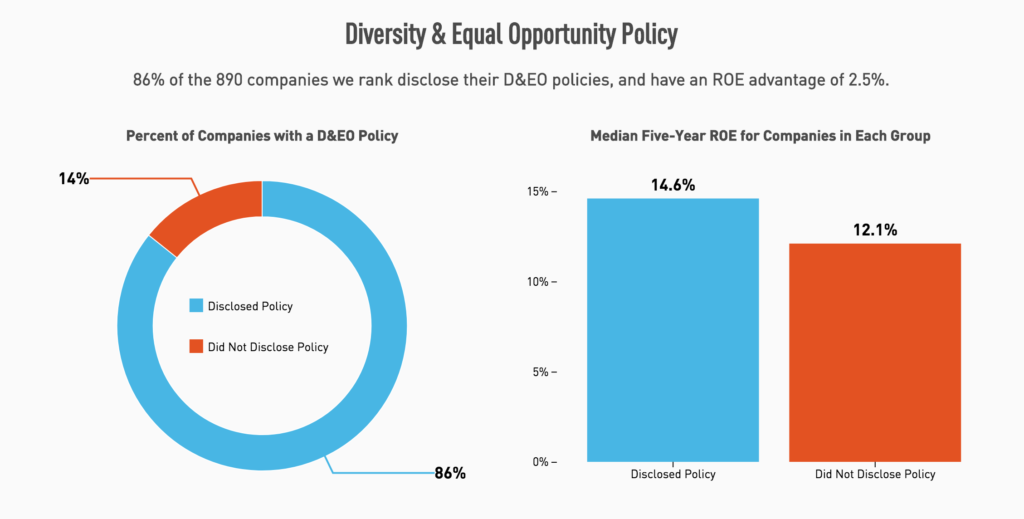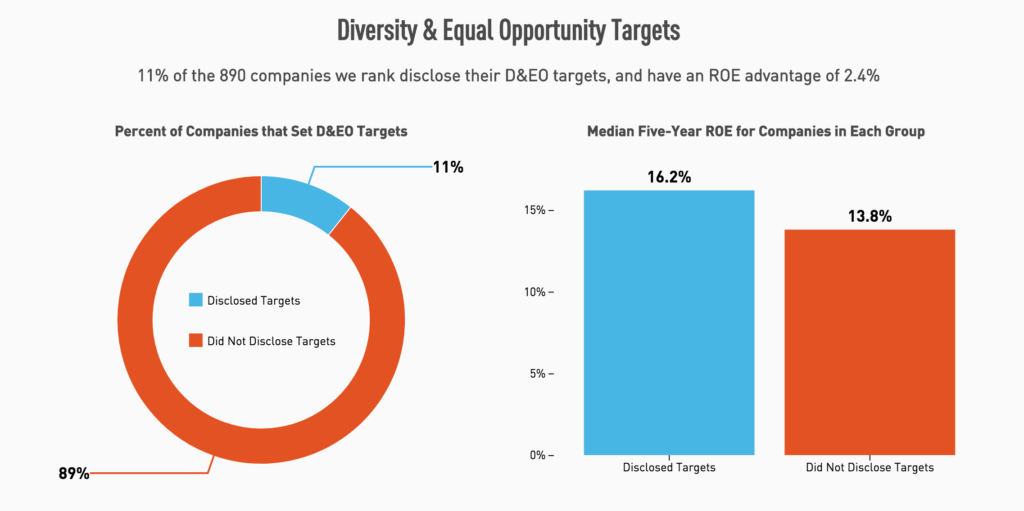The Catalytic Power of Transparency in Creating a Diverse Workforce
Q&A with Barbara Whye, Intel’s Chief Diversity & Inclusion Officer
Diversity, inclusion, and equal opportunity are cornerstones of just business, and awareness of the business case has been on the rise for years. An ongoing McKinsey Study – Why Diversity Matters – demonstrated in 2015 that companies in the top quartile for gender or racial and ethnic diversity were more likely to have financial returns above their industry medians.
Why? Companies that commit themselves to diverse leadership are able to win and retain talent, enhance decision-making, and improve customer experiences, which leads to a virtuous cycle of returns. McKinsey updated the research earlier this year, reaffirming the link between diversity and company financial outperformance, and its increasing importance.
Therefore, we weren’t surprised when our analysis of worker policies at 890 of the largest, publicly traded U.S. companies showed that 86% of companies disclosed a diversity and equal opportunity (D&EO) policy, and that those companies had a Return on Equity advantage of 2.5% against peers.

We were surprised, however, that in stark contrast to this strong commitment to diversity, only 11% of the 890 companies disclosed actual, measurable targets, even though there was a strong Return on Equity advantage of 2.4% over peers that did not disclose.

The data clearly suggests that companies are not ready to disclose their progress on D&EO. We were eager to explore why, what’s working in corporate America, and how we might help equip business leaders looking to lead on this critical issue, so we reached out to Barbara Whye, Intel’s Chief Diversity & Inclusion Officer and VP of Human Resources.

In 2015, Intel (which ranked 2nd overall and 1st in its industry in our model in 2018, and 1st overall in 2017), announced a bold goal to reach full representation in its U.S. workforce of women and underrepresented minorities by 2020. In other words, within five years, Intel’s workforce needed to reflect the demographic makeup of the total U.S. labor force, an impressive target that the company reached two years ahead of schedule in 2018.
In the interview below, Whye discusses Intel’s journey toward creating and reaching this goal, her advice to other corporate leaders looking to move the needle, and the catalytic power of committing to transparency.
Why do you think 86% of Russell 1000 companies disclose that they have a D&EO policy, but only 11% disclose their D&EO targets?
I think there is a fear that if you set targets, you might not reach them. No one likes to admit that they haven’t successfully reached a goal. However, there is power in transparency, setting goals, and measuring your progress, as it enables you to bring the entire workforce on the journey with you. It accelerates scaling solutions and driving the change at the right levels. This is why we publish annual diversity and inclusion reports and are transparent about areas of improvement. It’s the only way we as a company and the industry will truly move the needle on this work.
In 2018, IBM referred to its diversity and inclusion strategy as “closely guarded and competitively sensitive.” Did Intel feel any hesitation around putting this information out there? Why did disclosure win out?
There is absolutely power in data transparency, and we chose to disclose our numbers because it’s simply the right thing to do. By doing so, we also hold our employees and leaders accountable. It’s a strong leadership message to the rest of the industry that it takes all of us to tackle this challenge and we must be bold. By revealing our numbers, we hope to encourage other companies to do so as well so we can work on solutions together. The industry can be better and Intel is committed to being better and leading the industry forward. We also have worked to integrate our diversity and inclusion data into our broader disclosure and commitment to transparency, since we know investors are increasingly focused on this area – including our Corporate Responsibility Report, Annual Report on form 10K, and Proxy Statement.
Intel achieved its goal of full representation of women and underrepresented minorities in its U.S. workforce two years ahead of schedule last year. How’d that happen? What were some of the key components to Intel’s success?
Our workforce now reflects the percent of women and underrepresented minorities available in the skilled labor market in the U.S. This achievement was the result of a comprehensive strategy that took into account hiring, retention, and progression. Reaching this goal is a testament to the hard work of our employees as well as the investments we’ve made in people, our partners, and communities around the world. Our work does not stop here. We continue to foster an inclusive culture where employees can bring their full experiences and authentic selves to work.
What are some of the “table stakes” initiatives that every company should adopt tomorrow to achieve DE&O goals?
As a company-wide initiative, all our full-time employees had a portion of their annual performance bonus tied to the achievement of our diverse hiring and retention goals. This helps incentivize and enlist employees in our diversity journey. Approximately 7% of qualifying employees’ annual bonuses was tied to meeting our annual diversity hiring and retention goals.
We also have a D+I executive leadership team which has been critical to setting and reaching our goals. The committee meets with me once a month to discuss our progress and challenges companywide. Leadership teams must see the value of this work in order to make progress.
What are some of the more unique initiatives that you prototyped? What are you most proud of?
Retaining key talent is important to Intel, and we want to help before employees feel they’ve run out of options, so in 2016 we launched Intel’s confidential hotline, Warmline, to provide employees with the support they need to work through personal and professional roadblocks and improve the overall employee experience. To date, the Warmline has received more than 20,000 cases and case managers have an 82% retention rate.
Now we have a robust data set to identify patterns, locate problem areas, and address issues proactively and systemically. Starting January 2019, we began rolling the program out globally, extending real-time support and guidance at scale. The Warmline case managers are driven by a goal of promoting diversity and inclusion within the workplace and between employees, encouraging them to be their best selves. The Warmline is also private and personal, helping users feel heard and understood by an objective third party outside of normal business HR. For these reasons we are very proud to be bringing this program to Intel globally so that we can continue in our mission to encourage a community of openness, belonging, and inclusion.
It’s great to hear that you’ve created programs specifically addressing retention. Do you have others that help to decrease turnover and ensure women and underrepresented minorities stay on?
Our retention programs are more targeted than ever. In addition to the Warmline, we have Employee Resource Groups, leadership councils, mentor circles, formal sponsorship programs, Career Connections, Career Zone and short-term development opportunity assignments. Connecting employees through forums, groups, training, and events has been a longstanding hallmark of Intel’s workplace culture. Employees cultivate tools to navigate Intel, so they can more quickly and successfully build and foster connections and community.
Tim Ryan, co-founder of CEO Action for Diversity and Inclusion, wrote a byline in Fortune on Why Focusing on Diversity Numbers Won’t Really Make Companies More Inclusive, as it can create tunnel vision, where the underlying cultural issues don’t get addressed. Do you agree/disagree?
I agree that focusing only on diversity numbers won’t change anything. That’s why it’s important to address both diversity and inclusion. You need to keep yourself accountable with the numbers but the real work happens trying to transform your company culture and inherent bias in people.
Previously, Intel launched a study of Multicultural Retention and Progression and surveyed over 7,000 employees to better understand the barriers to retaining and progressing underrepresented minorities. We developed a set of best practices for our managers to mitigate the influence of unconscious bias in the hiring process. Central to these practices are opening a requisition, using an impartial description of qualifications, interviewing a diverse slate of candidates, and having a diverse hiring panel.
Where do you go now? What’s next after achieving representation two years ahead of schedule?
We started expanding the Warmline service globally this year, driving leadership parity, and focusing on our gaps with women of color. We also just launched a formalized ally program that is a resource for our employees to learn how to become part of a community that supports everyone to be the best they can be in an environment of collaboration and understanding.






